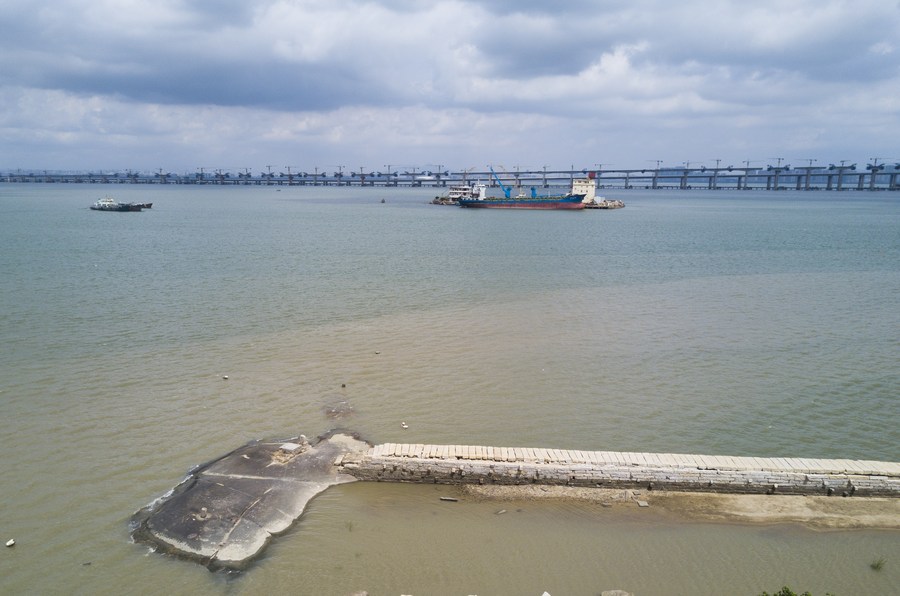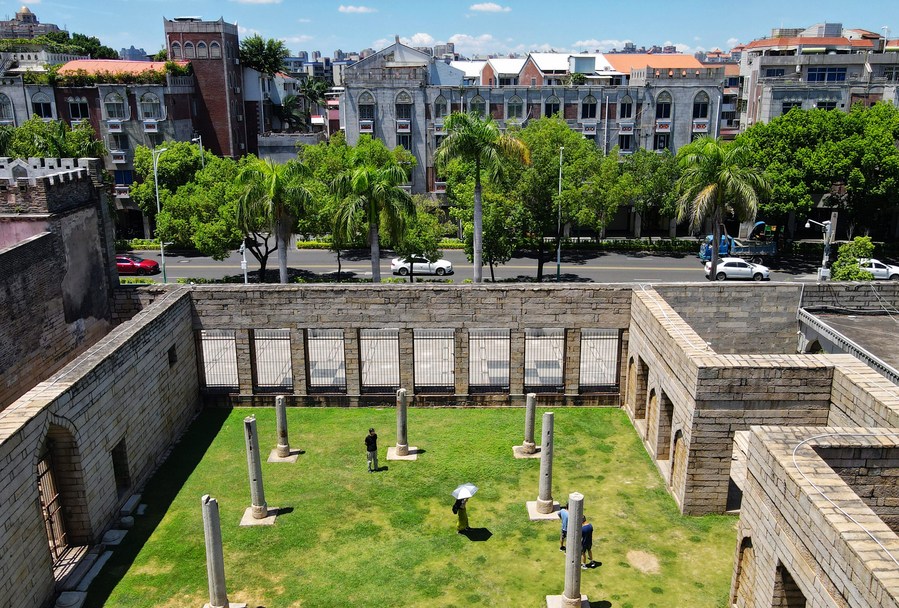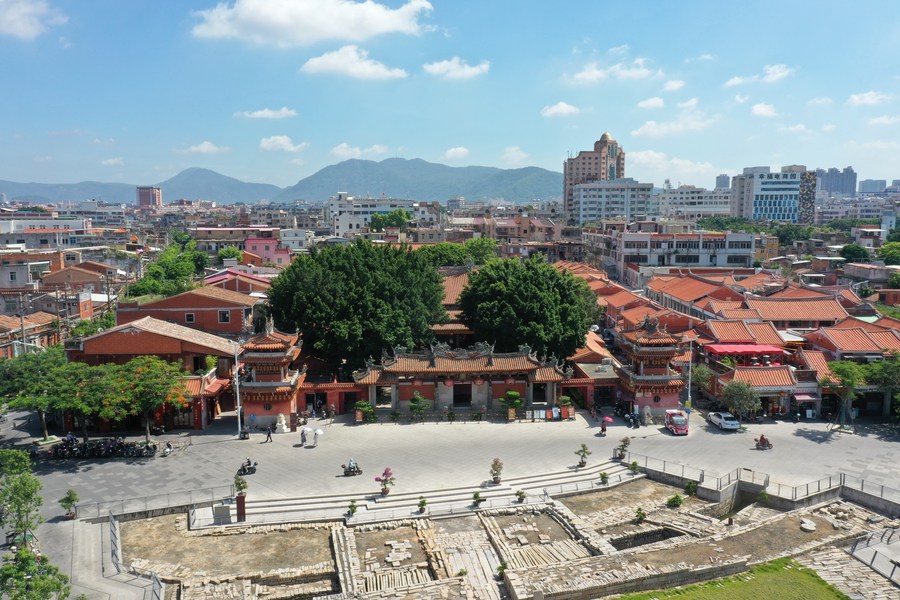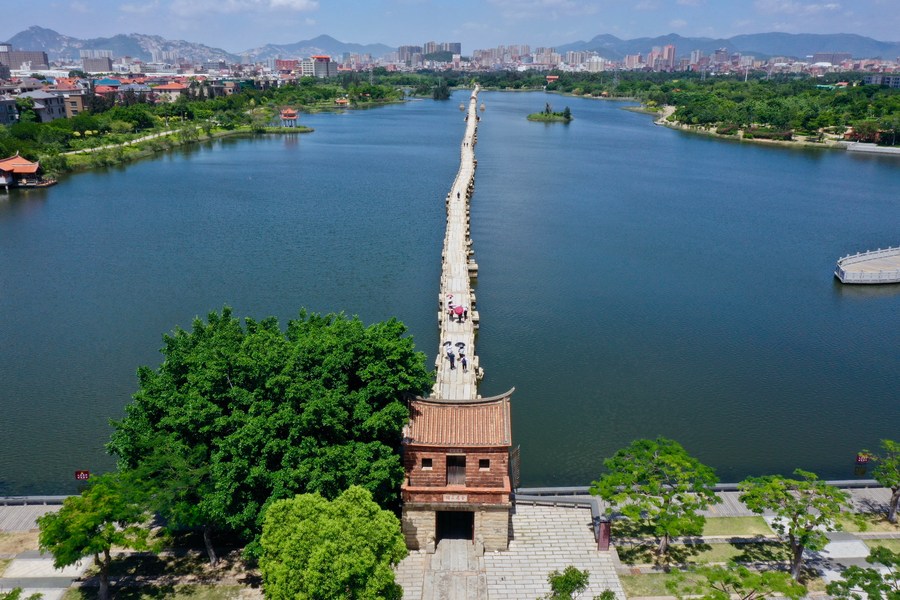-- East China's port city of Quanzhou, once hailed as "the very great and noble city" by the Italian explorer Marco Polo, won UNESCO World Cultural Heritage status Sunday, bringing the total number of the country's UNESCO World Heritage sites to 56.
-- The serial property includes 22 sites of administrative buildings and structures, religious buildings, and statues.
-- The property witnessed multi-cultural communities, cultural memorial sites and monuments, the production of ceramics and iron, and a transportation network formed of bridges, docks and pagodas that guided voyagers.
Historical sites in east China's port city of Quanzhou won UNESCO World Cultural Heritage status on Sunday, bringing the total number of the country's UNESCO World Heritage sites to 56.
UNESCO accepted "Quanzhou: Emporium of the World in Song-Yuan China" as a cultural property on its World Heritage List amid the ongoing 44th session of the World Heritage Committee held in Fuzhou, capital of east China's Fujian Province.
Located on narrow plains along the coastline of Fujian, Quanzhou was one of the world's largest ports along the historic Maritime Silk Road, particularly in ancient China's Song Dynasty (960-1279) and Yuan Dynasty (1271-1368).

Aerial photo taken on July 7, 2021 shows the ancient ferry of Shihu Dock in Shishi City, Quanzhou, southeast China's Fujian Province. (Xinhua/Song Weiwei)
The serial property includes 22 sites of administrative buildings and structures, religious buildings, and statues. The property witnessed multi-cultural communities, cultural memorial sites and monuments, the production of ceramics and iron, and a transportation network formed of bridges, docks and pagodas that guided voyagers.
"It reflects greatly the spatial structure that combined production, transportation and marketing. It demonstrates the key institutional, social and cultural factors that contributed to the spectacular rise and prosperity of Quanzhou as a maritime hub of the East and Southeast Asia trade network during the 10th to 14th centuries AD," said a report by the International Council on Monuments and Sites (ICOMOS), the committee's official advisory body.

Aerial photo taken on July 24, 2021 shows Qingjing Mosque in Quanzhou, southeast China's Fujian Province. (Xinhua/Wei Peiquan)
CONVERGENCE OF COMMERCE AND CULTURE
The newly inscribed cultural property, comprising 22 functionally and spatially connected historical relics, attests to the indispensable contributions China made to the prosperity of global maritime trade and the development of East and Southeast Asia.
In fact, it is the second time the city has applied for the prestigious title. In 2018, China's nomination "Historic Monuments and Sites of Ancient Quanzhou (Zayton)" was referred back for a second chance when the committee met in Bahrain in 2018.
China made significant technical adjustments and resubmitted the application as "Quanzhou: Emporium of the World in Song-Yuan China," with the former 16 sites included in the serial nomination expanded to 22 sites, according to Zhang Lei. Zhang is head of the world cultural heritage department under China's National Cultural Heritage Administration (NCHA) and made the remarks at a press conference held earlier this month.

Aerial photo taken on July 8, 2021 shows Tianhou Temple in Licheng District of Quanzhou City, southeast China's Fujian Province. (Xinhua/Lin Shanchuan)
"It is not only a joyful event for about 8.78 million people of Quanzhou but also a great occasion for all Chinese. It is also a blessing for people of the world who cherish historical and cultural heritage and love maritime civilization," said Wang Yongli, Party chief of Quanzhou City.
"We will shoulder more responsibility and make a stronger commitment to protect, inherit, and make good use of our precious heritage," Wang added.
The historical sites help tell silent tales of Quanzhou's glorious past. Back in the Song and Yuan dynasties, kilns were sprinkled around the city to make exquisite porcelain for export, while bridges and docks saw cartloads of goods come and go.
Quanzhou's buzzing markets and busy docks also featured prominently in the writings of famous medieval explorer Marco Polo.
"And I assure you that for one shipload of pepper that goes to Alexandria or elsewhere, destined for Christendom, there come a hundred such, aye and more too, to this haven of Zayton; for it is one of the two greatest havens in the world for commerce," wrote Marco Polo in his book on travels.
The maritime trade tradition, which cherishes inclusiveness, diversity, and common prosperity, has turned ancient Quanzhou into a focal point for commerce and a melting pot of diverse cultures.
In ancient times, people of different religious beliefs gathered and lived in harmony in Quanzhou, leaving many religious relics and cultural legacies such as mosques and temples.
Dubbed "the museum of the world's religions," Quanzhou City today still boasts venues of at least four different religions and beliefs.
"Quanzhou's serial sites have helped display the splendid history of exchanges and mutual learning between the Chinese civilization and the world," said Li Qun, head of NCHA.
While spreading to the world ancient China's agricultural technologies, literary classics, and philosophical thoughts via maritime commerce and trade, the city also learned from other cultures and provided available space where different cultures and religions can coexist and integrate, Li added.
The spirit of inclusiveness and common prosperity, embodied by the ancient city, runs in a similar vein with the country's current pursuit of a shared future for all, said Li Guohong, a scholar in local folk culture.

Aerial photo taken on July 8, 2021 shows Anping Bridge in Anhai Town of Quanzhou, southeast China's Fujian Province. (Xinhua/Jiang Kehong)
HERITAGE FOR ALL HUMANITY
The international community congratulated China on Quanzhou's inscription onto the World Heritage List and applauded the country's efforts to preserve the relics in a city full of cultural vim and economic vibrancy.
"It is a great victory of the Quanzhou people. May Quanzhou be now better known to the world and recognized as Ground Zero of Maritime Silk Roads for Peace and Intercultural Dialogue," said Doudou Diene, former director of the Division of Intercultural Dialogue of UNESCO.
"It reflects great recognition from the World Heritage Committee on Quanzhou's outstanding universal value as a window for economic and cultural exchanges, a major port along the Maritime Silk Road, as well as a global maritime trade center back in the Song and Yuan dynasties," said China's Vice Minister of Education Tian Xuejun.
It also demonstrated that the international community highly affirmed the significance and historical value of Quanzhou in promoting mutual learning, sustainable development, and building a community with a shared future for humanity, said Tian, who is also the director of the Chinese National Commission for UNESCO and chair of the 44th session of the World Heritage Committee.
The Chinese government pledged to ramp up efforts and deepen international cooperation to better protect and manage the World Heritages in China.
"Since the accession of the World Heritage Committee, China has always worked closely with other state parties and relevant international organizations to preserve and inherit the collective treasure of humanity. In the future, China will continuously keep its commitment to and take more responsibility for World Culture Heritage by enhancing the conversation, management, and international cooperation," said NCHA chief Li Qun.
China is committed to working with UNESCO, state parties to the World Heritage Committee, and professional advisory bodies to promote international exchanges and cooperation in World Heritage protection and proper use while making new and greater contributions to the noble cause, said Tian.
